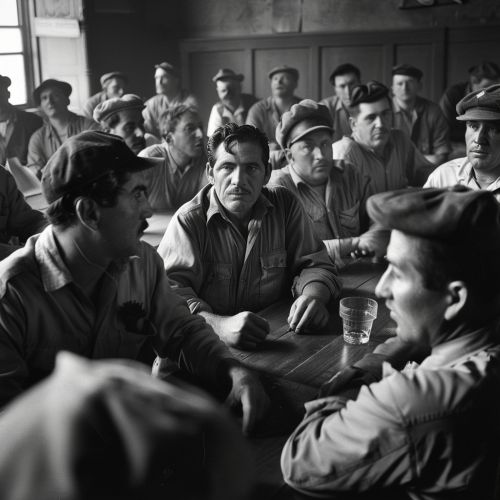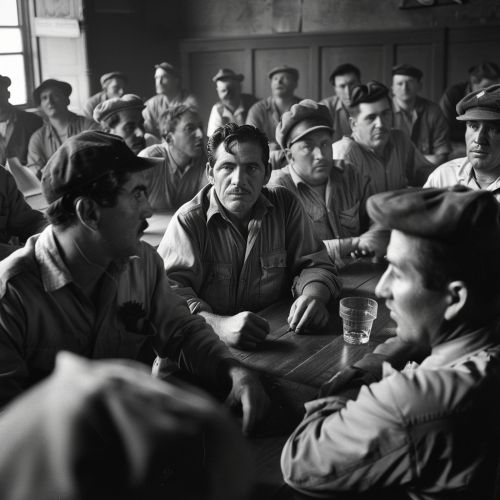Labor Unions: Difference between revisions
(Created page with "== Introduction == Labor unions, also known as trade unions, are organized associations of workers formed to protect and advance their rights and interests. These organizations play a crucial role in negotiating wages, working conditions, and other aspects of employment through collective bargaining. Labor unions have a rich history and have significantly influenced labor laws and workplace standards globally. == History of Labor Unions == The origins of labor unions ca...") |
No edit summary |
||
| Line 14: | Line 14: | ||
The 20th century saw significant advancements in labor rights, driven by the efforts of unions. The [[Wagner Act]] of 1935, also known as the National Labor Relations Act, guaranteed workers the right to form unions and engage in collective bargaining. The post-World War II era witnessed the rise of powerful unions, such as the [[United Auto Workers (UAW)]] and the [[Teamsters]]. | The 20th century saw significant advancements in labor rights, driven by the efforts of unions. The [[Wagner Act]] of 1935, also known as the National Labor Relations Act, guaranteed workers the right to form unions and engage in collective bargaining. The post-World War II era witnessed the rise of powerful unions, such as the [[United Auto Workers (UAW)]] and the [[Teamsters]]. | ||
[[Image:Detail-97121.jpg|thumb|center|Workers gathered in a meeting, discussing union matters.|class=only_on_mobile]] | |||
[[Image:Detail-97122.jpg|thumb|center|Workers gathered in a meeting, discussing union matters.|class=only_on_desktop]] | |||
== Structure and Function of Labor Unions == | == Structure and Function of Labor Unions == | ||
Latest revision as of 00:08, 21 July 2024
Introduction
Labor unions, also known as trade unions, are organized associations of workers formed to protect and advance their rights and interests. These organizations play a crucial role in negotiating wages, working conditions, and other aspects of employment through collective bargaining. Labor unions have a rich history and have significantly influenced labor laws and workplace standards globally.
History of Labor Unions
The origins of labor unions can be traced back to the Industrial Revolution in the late 18th and early 19th centuries. During this period, rapid industrialization led to the growth of factories and mass production, resulting in poor working conditions, long hours, and low wages for workers. In response, workers began to organize themselves to demand better conditions and fair treatment.
Early Beginnings
The first labor unions emerged in Europe, particularly in the United Kingdom, where the Combination Acts of 1799 and 1800 initially prohibited workers from forming unions. Despite these restrictions, workers continued to organize secretly. The repeal of the Combination Acts in 1824 marked a significant milestone, allowing unions to operate legally.
Growth and Expansion
In the United States, labor unions began to form in the early 19th century. The National Trades' Union was established in 1834, marking the first attempt to create a national labor organization. The labor movement gained momentum after the Civil War, with the formation of the Knights of Labor in 1869 and the American Federation of Labor (AFL) in 1886.
20th Century Developments
The 20th century saw significant advancements in labor rights, driven by the efforts of unions. The Wagner Act of 1935, also known as the National Labor Relations Act, guaranteed workers the right to form unions and engage in collective bargaining. The post-World War II era witnessed the rise of powerful unions, such as the United Auto Workers (UAW) and the Teamsters.


Structure and Function of Labor Unions
Labor unions are typically structured in a hierarchical manner, with local unions representing workers at individual workplaces, and national or international unions overseeing multiple local unions.
Local Unions
Local unions are the fundamental units of labor organizations. They represent workers at specific workplaces or within particular industries. Local unions are responsible for negotiating collective bargaining agreements, handling grievances, and organizing strikes or other collective actions.
National and International Unions
National unions, such as the AFL-CIO in the United States, coordinate the activities of local unions and provide support in negotiations, legal matters, and political advocacy. International unions, like the International Trade Union Confederation (ITUC), represent workers' interests on a global scale and promote labor rights across borders.
Collective Bargaining
Collective bargaining is the process through which unions negotiate with employers on behalf of their members. This process aims to reach agreements on wages, working conditions, benefits, and other employment terms. Successful collective bargaining can lead to collective bargaining agreements (CBAs), which are legally binding contracts.
Impact of Labor Unions
Labor unions have had a profound impact on various aspects of employment and society. Their influence extends beyond the workplace, affecting labor laws, social policies, and economic conditions.
Wage and Benefit Improvements
One of the primary achievements of labor unions is the improvement of wages and benefits for workers. Through collective bargaining, unions have secured higher wages, health insurance, pensions, and other benefits for their members.
Workplace Safety and Conditions
Unions have played a critical role in advocating for safer working conditions. The establishment of organizations like the Occupational Safety and Health Administration (OSHA) in the United States can be attributed to union efforts. Unions continue to monitor and enforce workplace safety standards.
Social and Political Influence
Labor unions have also been influential in shaping social and political landscapes. They have been involved in advocating for labor-friendly legislation, supporting political candidates, and participating in social movements. For example, unions were instrumental in the passage of the Fair Labor Standards Act of 1938, which established minimum wage and overtime pay standards.
Challenges and Criticisms
Despite their contributions, labor unions face several challenges and criticisms. These issues have led to a decline in union membership and influence in recent decades.
Decline in Membership
Union membership has been declining in many countries, particularly in the private sector. Factors contributing to this decline include globalization, changes in labor markets, and anti-union policies. In the United States, union membership peaked in the 1950s but has since decreased significantly.
Criticisms of Unions
Labor unions have faced criticism for various reasons. Some argue that unions can create inefficiencies by protecting underperforming workers and resisting necessary changes. Others criticize unions for corruption and mismanagement. High-profile cases, such as the corruption scandals involving the Teamsters, have tarnished the reputation of unions.
Legal and Political Challenges
Unions also face legal and political challenges. In some countries, laws restrict union activities, making it difficult for workers to organize. Additionally, political opposition from conservative groups and business interests can undermine union efforts. The Right-to-Work laws in the United States, which allow employees to opt out of union membership and dues, have weakened unions' financial stability.
Future of Labor Unions
The future of labor unions is uncertain, but they continue to adapt to changing economic and social conditions. Unions are exploring new strategies to remain relevant and effective in the modern workforce.
Technological Advancements
Technological advancements, such as automation and artificial intelligence, are transforming the labor market. Unions are working to address the impact of these changes on workers, advocating for retraining programs and protections against job displacement.
Globalization
Globalization presents both challenges and opportunities for labor unions. While it has led to job losses in some industries, it has also created new avenues for international solidarity and cooperation. Unions are increasingly collaborating across borders to address issues like labor exploitation and environmental sustainability.
New Forms of Organizing
Unions are experimenting with new forms of organizing to reach workers in non-traditional employment arrangements, such as gig economy workers and independent contractors. Initiatives like the Fight for $15 campaign, which advocates for a higher minimum wage, demonstrate unions' ability to mobilize diverse groups of workers.
See Also
- Collective Bargaining
- Occupational Safety and Health Administration (OSHA)
- Right-to-Work laws
- Fair Labor Standards Act
- International Trade Union Confederation (ITUC)
References
- To be added if needed.
